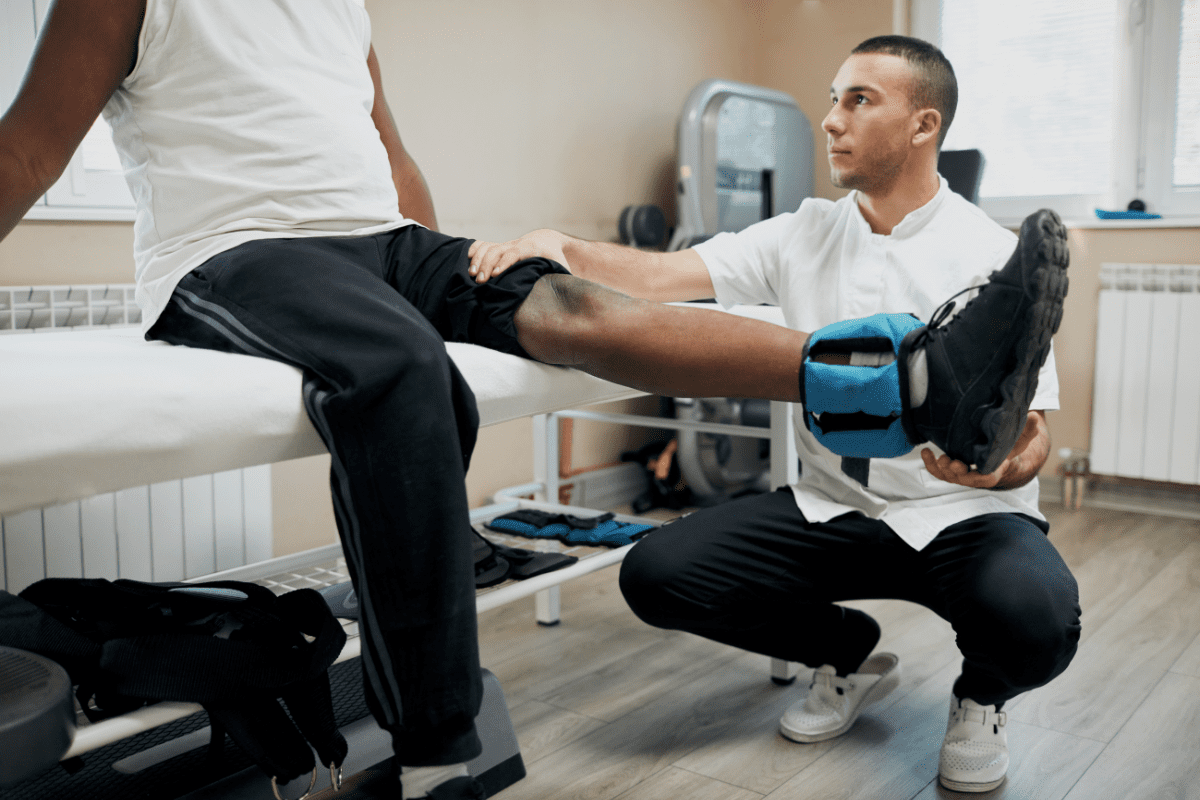Have you recently been injured in Florida and wondered if physical therapy could help you recover faster?
Whether it’s from a car accident, a sports injury, or a workplace incident, physical therapy after an injury in Florida is a crucial part of the recovery process, especially when it comes to improving mobility, reducing pain, and preventing long-term damage. Whether you’ve been in a car accident, experienced a sports injury, or suffered a work-related injury, starting physical therapy early can make a significant difference in how quickly and fully you recover. In this article, we’ll explore why physical therapy is essential after an injury, how it can help you heal, and what you can expect from a comprehensive physical therapy treatment plan in Florida.
What is Physical Therapy and Why Is It Important After an Injury?
Physical therapy, often referred to as PT, is a form of treatment designed to improve movement, relieve pain, and restore function after an injury or illness. In Florida, physical therapy plays a key role in helping individuals recover from injuries sustained in auto accidents, sports, and other physical activities. It is particularly vital in preventing injuries from becoming chronic or debilitating.
Physical therapy focuses on targeted exercises and therapies that help strengthen muscles, improve range of motion, and restore mobility and function in the affected area. Whether you’re dealing with whiplash from a car accident or a sprain from a fall, physical therapy can help you regain strength and reduce pain.
Why is Physical Therapy So Important?
- Preventing Chronic Pain: Injuries that go untreated or are not properly rehabilitated can lead to chronic pain. Physical therapy helps prevent this by ensuring proper healing and strengthening of the injured area.
- Restoring Functionality: Many injuries, especially to the spine or ligaments, can severely impact your ability to perform everyday activities. Physical therapy helps restore your ability to move and function as you did before your injury.
- Avoiding Surgery: In some cases, physical therapy can act as a non-surgical treatment option for injuries that might otherwise require invasive procedures. By improving mobility and strengthening the body, physical therapy can often help patients avoid the need for surgery.
Research has shown that early intervention with physical therapy reduces recovery time and improves long-term outcomes for many types of injuries. According to the American Physical Therapy Association, starting therapy early after an injury can prevent complications and speed up recovery.
Key Benefits of Physical Therapy After an Injury
- Increased blood flow to the injured area to promote faster healing.
- Improved strength and flexibility in weakened muscles and joints.
- Restored range of motion to help you get back to daily activities.
- Prevention of future injuries by improving body mechanics and posture.
We’ve helped many clients recover from car accident injuries and other accidents through personalized therapy plans. To learn more about the benefits of seeking therapy after an accident, check out our guide on 9 Important Reasons to Seek Physical Therapy After a Car Accident in Palm Beach County.
The Role of Physical Therapy After an Auto Accident Injury in Florida
If you’ve been in an auto accident in Florida, seeking physical therapy is one of the most important steps you can take toward recovery. Car accident injuries like whiplash, back pain, and sprains often go unnoticed in the immediate aftermath of the accident, but these injuries can worsen over time if not treated. This is why starting physical therapy as soon as possible is critical, even if you don’t feel severe pain immediately after the crash.
Common Injuries Treated by Physical Therapy After an Auto Accident
- Whiplash: This neck injury is caused by a rapid back-and-forth movement of the head during an accident, which can result in stiffness, pain, and decreased range of motion. Physical therapy can help reduce pain and restore mobility through exercises and manual therapy.
- Back Pain: The impact of a car accident often leads to spinal injuries or damage to the muscles and ligaments supporting the spine. Physical therapy helps relieve pain and strengthens the back to prevent future injury.
- Sprains and Strains: These soft tissue injuries are common after an accident and can severely limit your ability to perform daily activities. A personalized treatment plan can target these areas to improve healing and function.
In addition to addressing specific injuries, physical therapy provides long-term benefits by improving overall health, restoring range of motion, and helping prevent further injuries. In Florida, where the 14-day accident law applies, it’s essential to seek treatment, including physical therapy, within this timeframe to ensure that your Personal Injury Protection (PIP) benefits cover your treatment.
For more information on the 14-day accident law, you can read our detailed article on Navigating the 14-Day Accident Law in Florida: The Need to Know.
Why Physical Therapy is Critical for Auto Accident Recovery in Florida
- Reducing Pain and Inflammation: Injuries from a car accident can cause chronic pain and inflammation if left untreated. Physical therapy uses techniques such as electrical stimulation and massage therapy to reduce inflammation and promote healing.
- Restoring Mobility and Function: After an accident, it’s common to experience stiffness and loss of mobility. Physical therapy helps improve flexibility, strength, and range of motion to get you back to your daily routine.
- Preventing Long-Term Disability: Without proper treatment, injuries sustained in an auto accident can lead to long-term issues or permanent disability. Physical therapy helps prevent these outcomes by providing rehabilitative care that focuses on restoring function and strength.
We understand how difficult the recovery process can be after a car accident. That’s why we’re here to support you every step of the way, including helping you find the right physical therapy services to meet your needs. For more information on what to do after a car accident, check out our article on Delayed Injuries After a Florida Car Crash.
How Physical Therapy Can Help Speed Up the Healing Process
After an injury, the body’s natural healing process can sometimes be slow, especially if the injury is severe or involves soft tissue damage. This is where physical therapy can make a significant difference in your recovery timeline. In Florida, physical therapy plays a key role in helping accident victims recover faster and more efficiently by targeting the injured area with specialized treatments that improve blood flow, restore mobility, and strengthen the affected muscles.
Key Ways Physical Therapy Speeds Up Recovery
- Increased Blood Flow: Physical therapists use specific exercises and techniques to boost circulation around the injured area. This promotes faster healing by delivering more oxygen and nutrients to the damaged tissues, which can help reduce pain and inflammation.
- Improved Range of Motion: One of the biggest challenges after an injury is regaining full mobility. Whether you’re dealing with a sprain, strain, or more serious injury, physical therapy includes stretching and mobilization exercises designed to improve movement in the affected joints and muscles.
- Strengthening Weak Muscles: After an injury, it’s common for muscles around the injured area to weaken. Physical therapy focuses on strengthening these muscles to provide better support and prevent re-injury.
- Pain Relief: Through techniques like manual therapy, electrical stimulation, and massage, physical therapy helps reduce chronic pain and promotes healing in areas that may otherwise be difficult to treat.
Physical Therapy Techniques That Enhance Healing
Physical therapists use a range of methods tailored to each patient’s specific needs, depending on the type of injury. Here are some of the most effective techniques used to speed up recovery:
- Manual Therapy: This hands-on technique involves manipulating soft tissues and joints to reduce stiffness, improve blood flow, and promote healing.
- Electrical Stimulation: By using small electrical currents, this method stimulates the muscles and nerves, helping to reduce pain and inflammation in the affected area.
- Stretching and Strengthening Exercises: These exercises focus on improving flexibility, range of motion, and muscle strength, which are critical for a full recovery.
- Heat and Cold Therapy: This can reduce swelling and improve blood flow to the injured tissues, which can accelerate healing.
Studies show that patients who begin physical therapy shortly after an injury often recover faster than those who delay treatment. The sooner you begin working with a physical therapist, the quicker you can regain strength and function in the injured area. For more insights into how early intervention with therapy can aid in recovery, you can visit our article on 8 Questions to Ask Your Doctor After a South Florida Car Accident.
Common Injuries Treated with Physical Therapy After an Injury
In Florida, physical therapy is commonly used to treat a wide variety of injuries resulting from auto accidents, sports injuries, and work-related injuries. Whether you’ve suffered a mild sprain or a more severe injury like a ligament tear, physical therapy offers tailored treatments designed to help you regain mobility, strength, and overall functionality. Let’s explore some of the most common injuries that benefit from physical therapy and how specialized treatment can aid in the recovery process.
1. Sprains and Strains
- Sprains occur when the ligaments—the tissues that connect bones—are overstretched or torn, often in areas like the ankle or wrist.
- Strains involve overstretching or tearing of muscles or tendons, which can happen due to overuse or sudden injury.
Physical therapy treatments for sprains and strains focus on restoring range of motion through targeted exercises. Manual therapy may also be used to improve joint mobility and reduce stiffness in the affected area.
2. Whiplash
Whiplash is a common injury after car accidents, particularly rear-end collisions. It involves a rapid forward and backward motion of the neck, which can result in neck pain, stiffness, and headaches.
Physical therapy for whiplash typically includes:
- Gentle neck exercises to improve flexibility and restore motion.
- Massage therapy to reduce muscle tightness.
- Posture correction exercises to prevent further strain on the neck.
By addressing the underlying issues associated with whiplash, physical therapy can help you regain full neck function and prevent long-term discomfort.
3. Back and Spinal Injuries
Back pain is one of the most frequent complaints after an auto accident or sports injury. Whether the injury involves the spine, muscles, or ligaments, physical therapy plays a key role in reducing pain and restoring function.
- Spinal mobilization helps to align the spine and improve back mobility.
- Core-strengthening exercises are incorporated to support the spine and prevent further injury.
For individuals dealing with more severe spinal issues, physical therapy can help manage symptoms and may even delay or prevent the need for surgery. You can learn more about the impact of delayed treatment and how it affects injuries by reading our post on Delayed Injuries After a Florida Car Crash.
4. Ligament Injuries (ACL and Others)
Ligament injuries, especially ACL tears, are common in both sports and car accidents. The ACL (anterior cruciate ligament) in the knee is crucial for stability, and when it’s torn, it can significantly impact your ability to walk and perform daily activities.
Physical therapy for ACL injuries includes:
- Strengthening exercises to build the muscles around the knee and improve stability.
- Balance training to restore coordination and prevent future injury.
By working closely with a physical therapist, patients with ligament injuries can avoid surgery and improve the knee’s strength and function over time.
5. Orthopedic Injuries
Orthopedic injuries refer to any injuries to the bones, joints, muscles, or ligaments, often seen in auto accidents or workplace accidents. These types of injuries can vary in severity, but physical therapy is essential in managing pain, improving mobility, and restoring strength and flexibility.
- Joint mobilization techniques are used to increase flexibility and reduce stiffness.
- Strength-building exercises are customized to help you regain full function and range of motion in the injured area.
Benefits of Starting Physical Therapy Early After an Injury
One of the most important decisions you can make after sustaining an injury is to start physical therapy as soon as possible. Early intervention plays a crucial role in speeding up recovery, preventing chronic pain, and minimizing long-term complications. In Florida, where accidents can result in anything from minor sprains to severe injuries, physical therapy provides a non-invasive and effective path to healing.
Why Early Physical Therapy is Critical
Starting physical therapy early has several key benefits that can significantly impact your overall recovery:
- Prevention of Chronic Pain: Injuries that are not treated promptly can lead to lingering pain, which can become chronic. By beginning physical therapy soon after the injury, you reduce the risk of long-term pain by promoting proper healing from the start.
- Faster Recovery: Physical therapy helps stimulate the body’s natural healing processes. Techniques such as manual therapy and electrical stimulation increase blood flow to the injured tissues, which promotes faster healing and reduces inflammation.
- Restoring Mobility Sooner: Injuries often result in stiffness and loss of mobility in the affected area. Physical therapy focuses on restoring range of motion through targeted exercises and stretches, which can help you regain mobility more quickly.
- Preventing Surgery: In many cases, early physical therapy can prevent the need for surgery. Strengthening the muscles around the injured area and improving mobility can often eliminate the need for more invasive treatments, such as surgery.
- Reducing the Risk of Future Injuries: Early physical therapy also emphasizes injury prevention. By improving body mechanics and teaching proper movement techniques, therapists help you avoid re-injury, which is particularly important for those recovering from sports injuries or work-related accidents.
What Happens if You Delay Physical Therapy?
Delaying physical therapy can lead to several negative consequences that can complicate your recovery process:
- Increased pain and stiffness: Without early treatment, injured muscles and joints can become stiff, and pain may worsen over time.
- Longer recovery times: Delaying physical therapy means you are missing out on the benefits of early intervention, which can significantly extend your recovery timeline.
- Higher risk of surgery: Injuries that are not properly managed through physical therapy may eventually require surgical intervention to correct, especially in cases involving the spine or ligaments.
In Florida, many accident victims are unaware of the importance of starting physical therapy within the first few weeks after an injury. This delay often leads to longer recovery times and more complex treatments later on. To avoid these issues, we recommend starting therapy as soon as possible after an accident.
When Should You Start Physical Therapy?
The general recommendation is to start physical therapy within 48 to 72 hours after an injury or as soon as you receive medical clearance from your doctor. Even if your injury seems minor, early therapy can help ensure that your body heals properly and doesn’t develop complications.
Whether you’ve been in an auto accident or suffered a work-related injury, early physical therapy can prevent the development of chronic pain and get you back to your normal activities faster.
Physical Therapy as a Non-Surgical Treatment Option
For many injuries, physical therapy offers a highly effective, non-invasive alternative to surgery. In Florida, where injuries from auto accidents, sports, and workplace accidents are common, physical therapy can play a significant role in helping patients avoid surgery while still achieving a full recovery. By focusing on strengthening, mobility, and pain management, physical therapy can be a preferred option for many patients who want to avoid the risks and lengthy recovery times associated with surgical procedures.
How Physical Therapy Can Replace Surgery
In some cases, physical therapy can completely eliminate the need for surgery by addressing the injury at its root and promoting healing through non-invasive means. Here’s how it works:
- Strengthening Surrounding Muscles: For injuries such as ligament tears or joint problems, physical therapy focuses on strengthening the muscles around the injured area. By improving the strength and stability of these muscles, you can often compensate for the injury, reducing pain and restoring functionality.
- Improving Mobility and Function: Injuries often result in reduced range of motion and stiffness. Through exercises specifically designed to improve flexibility and joint mobility, physical therapy can help restore normal movement patterns without the need for surgical intervention.
- Reducing Pain and Inflammation: Non-surgical techniques like manual therapy, ultrasound therapy, and electrical stimulation are effective at reducing chronic pain and inflammation, helping patients manage their symptoms without resorting to surgery.
- Enhancing the Body’s Natural Healing: Physical therapy promotes the body’s natural healing processes by increasing blood flow to injured tissues and encouraging tissue regeneration. In many cases, this natural healing can resolve the injury over time without surgical intervention.
Conditions That Can Benefit from Non-Surgical Physical Therapy
Physical therapy is a viable treatment option for a wide range of injuries and conditions, including:
- Sprains and Strains: Most soft tissue injuries, such as sprains and strains, can be successfully treated with physical therapy.
- Back Pain and Spinal Issues: Many spinal conditions, including herniated discs and spinal stenosis, can be managed with physical therapy, reducing the need for back surgery.
- Knee Injuries (ACL, MCL): Ligament injuries like ACL or MCL tears are common in sports, but with physical therapy, many athletes can avoid surgery and regain full function.
- Tendonitis and Bursitis: Inflammatory conditions affecting the tendons or bursae can often be treated through targeted exercises and manual therapy.
By addressing the injury conservatively, physical therapy allows you to regain strength and function without the recovery time and potential complications of surgery. According to research from the National Institutes of Health, patients who engage in physical therapy as an alternative to surgery often experience similar, if not better, long-term outcomes when it comes to mobility and pain relief.
Advantages of Choosing Physical Therapy Over Surgery
- No Downtime: Surgery often requires significant recovery time, with weeks or even months spent immobilized or limited in activity. With physical therapy, recovery is generally quicker and allows patients to stay active throughout the healing process.
- Lower Risk: Surgery comes with risks such as infection, blood clots, and anesthesia complications. Physical therapy, on the other hand, is a much safer option with minimal risks.
- Cost-Effective: Surgery can be costly, even with insurance. Physical therapy is a more affordable alternative that still provides excellent results.
While surgery is sometimes necessary for severe injuries, many patients in Florida find that physical therapy provides an effective, less invasive treatment option that leads to successful recovery. By working with an experienced physical therapist, you can achieve pain relief, restore function, and regain mobility without going under the knife.
Choosing the Right Physical Therapy Services in Florida
Selecting the right physical therapy services is crucial to ensuring a successful recovery after an injury in Florida. With so many options available, it’s important to find a therapist or clinic that understands your specific needs, whether you’ve been injured in a car accident, work-related incident, or sports injury. The right physical therapist will design a customized treatment plan that targets your injury and helps you recover as quickly and fully as possible.
Physical Therapy and Legal Support in Florida
In Florida, physical therapy services can be a crucial part of your overall recovery after an accident, but dealing with medical bills and insurance claims can sometimes be overwhelming. That’s where Bodden and Bennett Law Group can help. Our team works with clients to ensure they receive the proper medical attention, including physical therapy, after an injury. We also help you navigate your legal rights to compensation for medical costs, lost wages, and pain and suffering.
How Physical Therapy Improves Long-Term Health and Recovery
Physical therapy isn’t just about healing your injury in the short term—it plays a vital role in your long-term health and overall well-being. After an injury, especially one caused by a car accident or workplace incident, physical therapy provides the tools and techniques needed to ensure a full recovery, preventing further complications down the road. In Florida, physical therapy can help patients not only return to their daily routines but also avoid future injuries by improving body mechanics, strength, and flexibility.
1. Preventing Re-Injury
One of the most significant benefits of physical therapy is its ability to reduce the risk of re-injury. Often, injuries like sprains, strains, and whiplash leave patients vulnerable to further damage if not properly rehabilitated. Physical therapists focus on strengthening the muscles around the injured area, improving balance, and teaching proper movement techniques to ensure you don’t suffer the same injury again.
For example, if you’ve experienced a spinal injury, physical therapy will include exercises that strengthen the core muscles supporting your spine, reducing the likelihood of back problems in the future. This kind of preventative care is essential for avoiding chronic pain and long-term mobility issues.
2. Improving Mobility and Function
Injuries can leave you with limited range of motion and stiffness, which makes performing everyday activities difficult. Physical therapy focuses on improving mobility through exercises and manual therapy techniques that stretch and strengthen the injured muscles and joints. Over time, this restores full function, allowing you to return to work, sports, and other activities.
By focusing on body mechanics, physical therapy ensures that you move in ways that minimize stress on your body. For example, therapists might teach you how to lift objects properly, avoid repetitive strain, and maintain good posture to protect your spine and joints.
3. Enhancing Overall Physical Health
Physical therapy doesn’t just target the injury—it helps improve your overall health by addressing muscle imbalances, weaknesses, and poor posture that may have contributed to the injury. By focusing on holistic recovery, physical therapists can help you:
- Strengthen core muscles to support your spine and posture.
- Improve flexibility to enhance movement and prevent stiffness.
- Increase endurance to help you return to physical activities without pain.
By working on these aspects, patients often find that they feel better and move more efficiently after completing their physical therapy program than they did before the injury.
4. Managing Chronic Pain
For individuals suffering from chronic conditions like arthritis or long-term back pain, physical therapy provides a non-invasive way to manage pain. Through modalities such as heat therapy, electrical stimulation, and manual therapy, physical therapists help reduce inflammation and improve mobility. This helps patients avoid relying on medications or surgery for pain relief, which can have unwanted side effects.
In many cases, physical therapy provides a sustainable solution to managing pain, helping patients regain their independence and return to daily activities. Studies have shown that early and consistent physical therapy is one of the most effective ways to prevent chronic pain from becoming a debilitating issue.
5. Improving Mental Health and Well-Being
Recovering from an injury is not just about physical healing; it also impacts your mental health. Physical therapy can improve your mental well-being by helping you regain confidence in your body’s abilities. Completing therapy successfully and returning to your regular activities can boost your mood, reduce anxiety about re-injury, and provide a sense of accomplishment.
Furthermore, physical activity in general, including physical therapy exercises, is known to release endorphins, which improve mood and reduce feelings of depression and stress—common issues after a serious injury.
Get Legal Support After Your Injury—Contact Bodden and Bennett Law Group
If you’ve been injured in an accident, it’s important to seek both medical and legal assistance as soon as possible. At Bodden and Bennett Law Group, we can help you secure the compensation you deserve for medical expenses, including physical therapy. We understand the importance of a full recovery, and we’re here to guide you every step of the way.
Contact us today to schedule a consultation and discuss your case. Let us help you navigate the legal process while you focus on your recovery.




